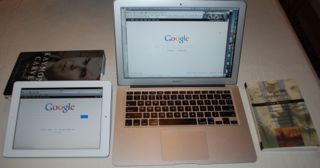Schools have been bringing new technologies into classrooms since the late 1970s. As each new wave of tools arrived, it was greeted with fanfare and enthusiastic promises of enhanced learning, thinking and problem-solving. Non-readers would learn to read. Non-thinkers would learn to think. If all students learned to program turtles moving on a screen (LOGO), their logical capabilities would be hugely improved.
Looking back at this experience, it would seem that many of these tools made a significant impact, indeed. They were not just full of sound and fury. But how does a school assess the impact of technologies to differentiate between the ones that have actually improved learning and those that have been foolish, peripheral and inconsequential?
Back in 1995 I wrote the following for the May/June issue of Multimedia Schools
-
What happens BEFORENET and AFTERNET?
With millions of new users jumping into Cyberspace and thousands of schools hopping on this latest educational bandwagon, the question is whether on not all the sound and fury signifies meaning.
-
Does "surfing" the Net lead to insight, truth and value, or is the Internet experience more akin to "Trivial Pursuit?" Does the typical user skim along the surface collecting trinkets and entertaining pictures, or does the Internet serve a deeper and more valuable purpose?
-
Driving onto the electronic highway is the easy part. Collecting hundreds of pages of information is also easy. The important — and often ignored — issue facing school leaders, teachers and library media specialists is the Importance of information problem-solving Skills. Effective use of the Internet depends upon the possession of strategic questioning, planning, searching and information-compacting skills.
|
This article suggests a half dozen questions to help discriminate between the consequential on the one hand and the unproductive on the other.
1. Has the innovation led to a qualitative improvement in the production of students? For example, has the kind of evidence provided to support arguments in student essays grown in value with the information resources now available thanks to the Web and the Hidden Web? Has the written expression of students gained in craftsmanship thanks to the editing capabilities of word processing? Is there evidence that later drafts have incorporated changes suggested by the Six Traits of Effective Writing?
2. Has the innovation led to efficiencies? For example, is it now possible to gather information and complete complicated tasks more rapidly and more effectively than previously? Has tedium been eliminated? Has mindless work been replaced by thoughtful tasks? Back in the 1970s researchers were still punching cards for the computer in order to do computer mapping of census data. This was incredibly time-consuming. The same data entry tasks have been radically streamlined so that students should be able to devote most of their time to the analysis of data rather than the entry of data.
3. Has the innovation led to a richer palette? For example, are students able to make a case more persuasively now because they can combine multimedia elements with well constructed essays? Are these elements used thoughtfully and powerfully? Or does the multimedia often seem more like flashy folderol?
4. Has the innovation led to a broader perspective? Have students emerged with a world view rather than a parochial view? Does access to citizens and news from around the world help them to step outside of the narrow viewpoints that often prevail when people lack such access?
5. Has the innovation led to deeper understandings? There has always been some danger that the Web would encourage a superficial take on the important issues and questions of our times. There have been complaints that plagiarism is on the increase. To what extent are students demonstrating original thinking and synthesis — actually constructing their own ideas rather than copying the ideas of others? Have they learned to probe below the surface in line with strategies articulated in the article, "Studying Complex Concepts such as Beauty, Truth and Courage in Depth?"
6. Has the innovation created convincing data to validate the above accomplishments? The National Assessment of Educational Progress provides a good model for schools to consider when addressing the assessment challenge. In looking at writing performance, for example, the NAEP Writing Report Card divides levels of performance into basic, proficient and advanced. An approach like this can be used to measure the growth seen in a school or a school district for number of program elements such as writing. Some might turn to surveys and measures of critical thinking skills. Has student capacity for deductive reasoning grown over time or remained flat? |


